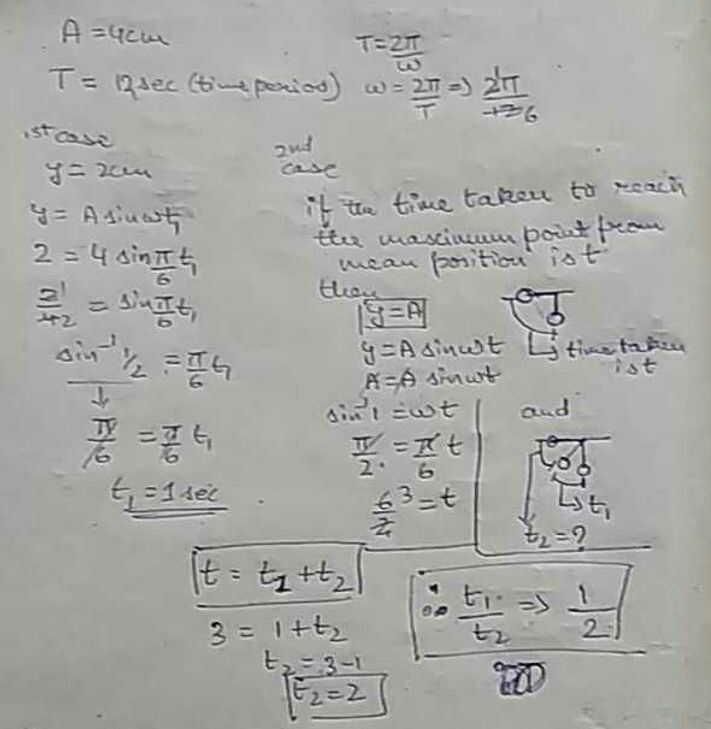Class 11 Exam > Class 11 Questions > A particle is executing S.H.M with an amplitu...
Start Learning for Free
A particle is executing S.H.M with an amplitude of 4 cm and time period 12 sec. The time taken by the particle in going from its mean position to a position of displacement equal to 2 cm is T1..The time taken from this displaced position of 2 cm to reach the extreme position is T2. Therefore, T1/ T2 will be
- a)1/ 3
- b)1/2
- c)41276.0
- d)1
Correct answer is option 'B'. Can you explain this answer?
Most Upvoted Answer
A particle is executing S.H.M with an amplitude of 4 cm and time perio...

Free Test
FREE
| Start Free Test |
Community Answer
A particle is executing S.H.M with an amplitude of 4 cm and time perio...
Given:
Amplitude (A) = 4 cm
Time period (T) = 12 sec
To find: T1/T2
Formula:
The time period (T) of a particle undergoing simple harmonic motion (SHM) is given by the formula:
T = 2π√(m/k)
Where:
m = mass of the particle
k = spring constant
In this case, the particle is executing SHM with an amplitude of 4 cm, which means the maximum displacement of the particle is 4 cm.
So, the displacement (x) of the particle at any time (t) can be given by the formula:
x = A cos(2πt/T)
Where:
A = amplitude
t = time
T = time period
From the given information, we can calculate the values of m and k.
1. Calculating mass (m):
The mass of the particle is not given, so we assume it to be 1 kg for simplicity.
2. Calculating spring constant (k):
Using the formula for time period:
T = 2π√(m/k)
Rearranging the formula, we get:
k = (4π²m)/T²
Substituting the values, we get:
k = (4π² * 1 kg)/(12 sec)²
k = (16π²)/144
k ≈ 0.348 N/m
Now, we can calculate T1 and T2.
3. Calculating T1:
T1 is the time taken by the particle to go from the mean position to a position of displacement equal to 2 cm.
Using the formula for displacement:
x = A cos(2πt/T)
Substituting the values, we get:
2 = 4 cos(2πt/T)
cos(2πt/T) = 0.5
2πt/T = π/3 (taking the inverse cosine of both sides)
t/T = 1/3
t = T/3
Therefore, T1 = T/3
4. Calculating T2:
T2 is the time taken by the particle to go from the displaced position of 2 cm to the extreme position.
Using the formula for displacement:
x = A cos(2πt/T)
Substituting the values, we get:
4 = 4 cos(2πt/T)
cos(2πt/T) = 1
2πt/T = 0 (taking the inverse cosine of both sides)
t = 0
Therefore, T2 = 0
Finally, we can calculate T1/T2.
T1/T2 = (T/3)/0 = 1/3
Hence, the correct answer is option B) 1/3.
Amplitude (A) = 4 cm
Time period (T) = 12 sec
To find: T1/T2
Formula:
The time period (T) of a particle undergoing simple harmonic motion (SHM) is given by the formula:
T = 2π√(m/k)
Where:
m = mass of the particle
k = spring constant
In this case, the particle is executing SHM with an amplitude of 4 cm, which means the maximum displacement of the particle is 4 cm.
So, the displacement (x) of the particle at any time (t) can be given by the formula:
x = A cos(2πt/T)
Where:
A = amplitude
t = time
T = time period
From the given information, we can calculate the values of m and k.
1. Calculating mass (m):
The mass of the particle is not given, so we assume it to be 1 kg for simplicity.
2. Calculating spring constant (k):
Using the formula for time period:
T = 2π√(m/k)
Rearranging the formula, we get:
k = (4π²m)/T²
Substituting the values, we get:
k = (4π² * 1 kg)/(12 sec)²
k = (16π²)/144
k ≈ 0.348 N/m
Now, we can calculate T1 and T2.
3. Calculating T1:
T1 is the time taken by the particle to go from the mean position to a position of displacement equal to 2 cm.
Using the formula for displacement:
x = A cos(2πt/T)
Substituting the values, we get:
2 = 4 cos(2πt/T)
cos(2πt/T) = 0.5
2πt/T = π/3 (taking the inverse cosine of both sides)
t/T = 1/3
t = T/3
Therefore, T1 = T/3
4. Calculating T2:
T2 is the time taken by the particle to go from the displaced position of 2 cm to the extreme position.
Using the formula for displacement:
x = A cos(2πt/T)
Substituting the values, we get:
4 = 4 cos(2πt/T)
cos(2πt/T) = 1
2πt/T = 0 (taking the inverse cosine of both sides)
t = 0
Therefore, T2 = 0
Finally, we can calculate T1/T2.
T1/T2 = (T/3)/0 = 1/3
Hence, the correct answer is option B) 1/3.

|
Explore Courses for Class 11 exam
|

|
Question Description
A particle is executing S.H.M with an amplitude of 4 cm and time period 12 sec. The time taken by the particle in going from its mean position to a position of displacement equal to 2 cm isT1..The time taken from this displaced position of 2 cm to reach the extreme position is T2. Therefore,T1/T2will bea)1/ 3b)1/2c)41276.0d)1Correct answer is option 'B'. Can you explain this answer? for Class 11 2025 is part of Class 11 preparation. The Question and answers have been prepared according to the Class 11 exam syllabus. Information about A particle is executing S.H.M with an amplitude of 4 cm and time period 12 sec. The time taken by the particle in going from its mean position to a position of displacement equal to 2 cm isT1..The time taken from this displaced position of 2 cm to reach the extreme position is T2. Therefore,T1/T2will bea)1/ 3b)1/2c)41276.0d)1Correct answer is option 'B'. Can you explain this answer? covers all topics & solutions for Class 11 2025 Exam. Find important definitions, questions, meanings, examples, exercises and tests below for A particle is executing S.H.M with an amplitude of 4 cm and time period 12 sec. The time taken by the particle in going from its mean position to a position of displacement equal to 2 cm isT1..The time taken from this displaced position of 2 cm to reach the extreme position is T2. Therefore,T1/T2will bea)1/ 3b)1/2c)41276.0d)1Correct answer is option 'B'. Can you explain this answer?.
A particle is executing S.H.M with an amplitude of 4 cm and time period 12 sec. The time taken by the particle in going from its mean position to a position of displacement equal to 2 cm isT1..The time taken from this displaced position of 2 cm to reach the extreme position is T2. Therefore,T1/T2will bea)1/ 3b)1/2c)41276.0d)1Correct answer is option 'B'. Can you explain this answer? for Class 11 2025 is part of Class 11 preparation. The Question and answers have been prepared according to the Class 11 exam syllabus. Information about A particle is executing S.H.M with an amplitude of 4 cm and time period 12 sec. The time taken by the particle in going from its mean position to a position of displacement equal to 2 cm isT1..The time taken from this displaced position of 2 cm to reach the extreme position is T2. Therefore,T1/T2will bea)1/ 3b)1/2c)41276.0d)1Correct answer is option 'B'. Can you explain this answer? covers all topics & solutions for Class 11 2025 Exam. Find important definitions, questions, meanings, examples, exercises and tests below for A particle is executing S.H.M with an amplitude of 4 cm and time period 12 sec. The time taken by the particle in going from its mean position to a position of displacement equal to 2 cm isT1..The time taken from this displaced position of 2 cm to reach the extreme position is T2. Therefore,T1/T2will bea)1/ 3b)1/2c)41276.0d)1Correct answer is option 'B'. Can you explain this answer?.
Solutions for A particle is executing S.H.M with an amplitude of 4 cm and time period 12 sec. The time taken by the particle in going from its mean position to a position of displacement equal to 2 cm isT1..The time taken from this displaced position of 2 cm to reach the extreme position is T2. Therefore,T1/T2will bea)1/ 3b)1/2c)41276.0d)1Correct answer is option 'B'. Can you explain this answer? in English & in Hindi are available as part of our courses for Class 11.
Download more important topics, notes, lectures and mock test series for Class 11 Exam by signing up for free.
Here you can find the meaning of A particle is executing S.H.M with an amplitude of 4 cm and time period 12 sec. The time taken by the particle in going from its mean position to a position of displacement equal to 2 cm isT1..The time taken from this displaced position of 2 cm to reach the extreme position is T2. Therefore,T1/T2will bea)1/ 3b)1/2c)41276.0d)1Correct answer is option 'B'. Can you explain this answer? defined & explained in the simplest way possible. Besides giving the explanation of
A particle is executing S.H.M with an amplitude of 4 cm and time period 12 sec. The time taken by the particle in going from its mean position to a position of displacement equal to 2 cm isT1..The time taken from this displaced position of 2 cm to reach the extreme position is T2. Therefore,T1/T2will bea)1/ 3b)1/2c)41276.0d)1Correct answer is option 'B'. Can you explain this answer?, a detailed solution for A particle is executing S.H.M with an amplitude of 4 cm and time period 12 sec. The time taken by the particle in going from its mean position to a position of displacement equal to 2 cm isT1..The time taken from this displaced position of 2 cm to reach the extreme position is T2. Therefore,T1/T2will bea)1/ 3b)1/2c)41276.0d)1Correct answer is option 'B'. Can you explain this answer? has been provided alongside types of A particle is executing S.H.M with an amplitude of 4 cm and time period 12 sec. The time taken by the particle in going from its mean position to a position of displacement equal to 2 cm isT1..The time taken from this displaced position of 2 cm to reach the extreme position is T2. Therefore,T1/T2will bea)1/ 3b)1/2c)41276.0d)1Correct answer is option 'B'. Can you explain this answer? theory, EduRev gives you an
ample number of questions to practice A particle is executing S.H.M with an amplitude of 4 cm and time period 12 sec. The time taken by the particle in going from its mean position to a position of displacement equal to 2 cm isT1..The time taken from this displaced position of 2 cm to reach the extreme position is T2. Therefore,T1/T2will bea)1/ 3b)1/2c)41276.0d)1Correct answer is option 'B'. Can you explain this answer? tests, examples and also practice Class 11 tests.

|
Explore Courses for Class 11 exam
|

|
Signup for Free!
Signup to see your scores go up within 7 days! Learn & Practice with 1000+ FREE Notes, Videos & Tests.


















